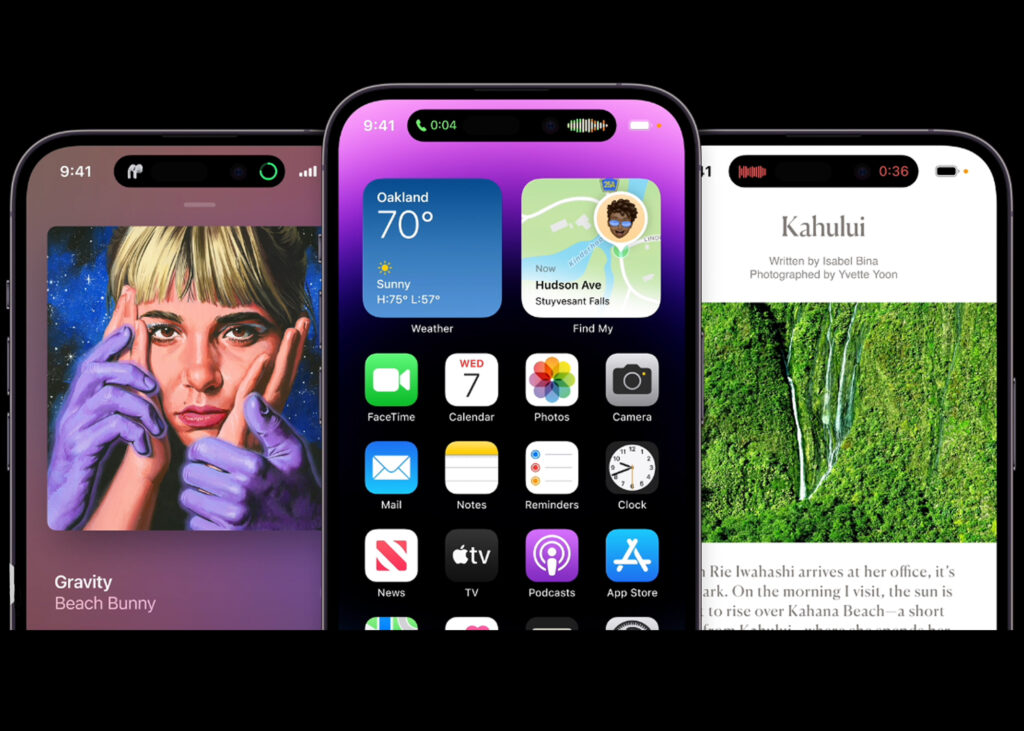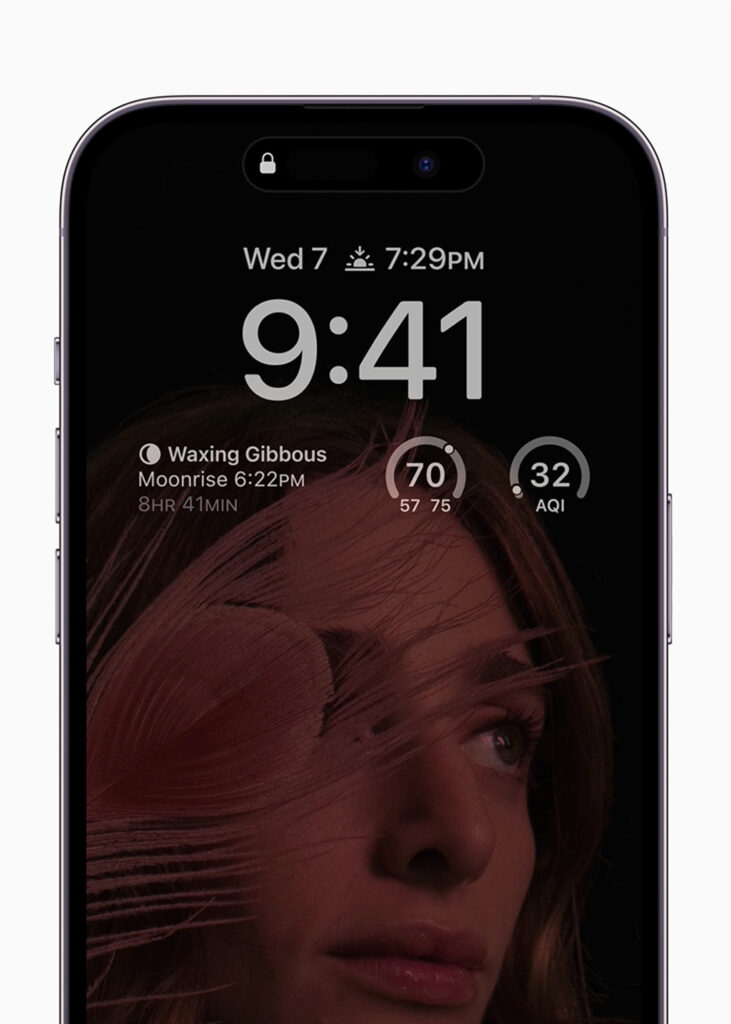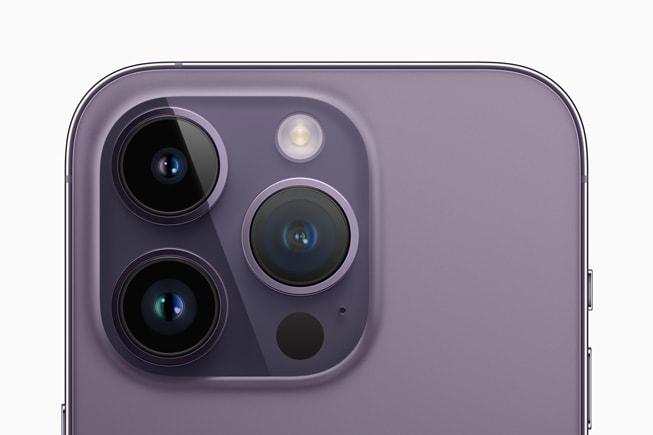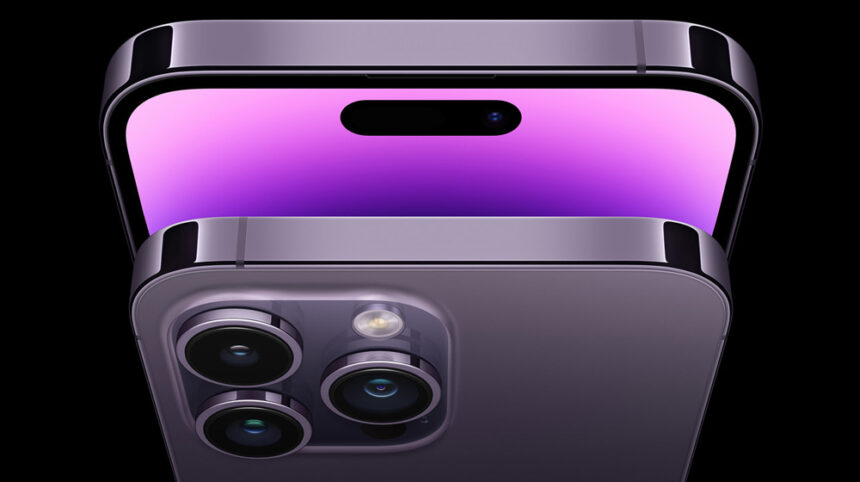Apple today announced iPhone 14 Pro and iPhone 14 Pro Max, the most advanced Pro lineup ever, featuring the Dynamic Island — a new design that introduces an intuitive way to experience iPhone — and the Always-On display. Powered by A16 Bionic, the fastest chip ever in a smartphone, iPhone 14 Pro introduces a new class of pro camera system, with the first-ever 48MP Main camera on iPhone featuring a quad-pixel sensor, and Photonic Engine, an enhanced image pipeline that dramatically improves low-light photos.
These groundbreaking advancements make iPhone even more indispensable for everyday tasks, creative projects, and now even emergency situations with features such as Emergency SOS via satellite and Crash Detection. iPhone 14 Pro and iPhone 14 Pro Max will be available in four gorgeous new finishes: deep purple, silver, gold, and space black. Pre-orders begin Friday, September 9, with availability beginning Friday, September 16.
Now, for the first time in a while, there are two different kinds of iPhones: the iPhone 14 and the iPhone 14 Plus, which I’ll call “Basic,” and the iPhone 14 Pro and the iPhone 14 Pro Max, which I’ll call “Premium.”
All of the iPhones got the same A15 Bionic chip last year. This year, the Apple iPhone 14 and 14 Plus get the new A15 Bionic, while the iPhone 14 Pro and Pro Max get the new A16 Bionic. Also, the iPhone 13 mini did not get an update, so it may be nearing the end of its life as a small phone.

Design, Materials & Display:
Nothing is wrong with how the iPhone 14 looks. It’s almost the same as the iPhone 13, but it might not be as good as the new iPhone 14 Pro and 14 Pro Max. Both of those phones have the new Dynamic Island, which is a place where the True Depth module and the display information can be put.

For people who aren’t familiar with the design language Apple started using with the iPhone 12, the 6.1-inch iPhone 14, is basically a thin slice of technology sandwiched between two pieces of expensive glass that may or may not be Gorilla Glass Victus. The Ceramic Shield is still on the cover screen. This should add another level of protection.
The aluminum band that holds the 173g, 75.1mm x 146.7mm x 7.65mm (0.30 inch) body together is smooth. The iPhone 13 has the same button placement, microphone placement, and speaker grill placement as the iPhone 13. On the right is the bigger button for power, sleep, and Siri. On the left is the slider for silence and the volume buttons below it. On the bottom, between the speaker grill and the mic holes, is what might be the last lightning port. Even though the European Union wants Apple to switch all of its devices’ ports to USB-C by 2024, this model will only have lighting. Your old wires and cables will be happy. This is the first iPhone to have an all-eSIM system instead of a physical SIM slot. It’s strange to see a smartphone without that instantly recognizable panel and the small hole for the special tool to pop out the SIM tray.
On the back is a camera array that looks about the same as it did on the iPhone 13. There are two 12MP cameras, one with a wide angle and one with an ultra-wide angle.
Because so many other things are the same, the iPhone’s new purple body colour may be the most interesting design change. Yes, purple is the “it” colour for gadgets this season. Apple is following Samsung’s lead by adding Bora purple to its iPhones, iPads, and iPods. Apple hasn’t changed much about the 6.1-inch Super Retina XDR screen on the iPhone 14 from the iPhone 13. It still has a resolution of 2532 x 1170 pixels at 460 ppi, and yes, it still has the notch. The notch is there to make room for the updated TrueDepth module, which has all the AR sensors and a 12MP camera.
Cameras & Battery Life:
The iPhone 14 from Apple has three cameras: a 12MP wide camera, a 12MP ultrawide camera, and a 12MP TrueDepth camera on the front.
Apple said that it made the main camera better by making the /1.5 aperture bigger and the 1.9 m pixels bigger. This should help the camera work better in low light. The 12MP wide-angle seems to be the same. But the TrueDepth camera on the front can now focus on its own.

Even though I only had a few minutes in the demo room, I did try all of the lenses and thought the pictures looked good, but I need more time with them. I did see the new autofocus feature of the TrueDepth camera in action, and I can see how that will be helpful.
There are also new ways to use the camera. Cinematic Mode can now record in 4K at both 30 and 24 frames per second. There’s also a brand-new Action Mode, which works like an electronic gimbal to smooth out shaky video by smart-cropping it on the fly. Cool idea, but I think you lose a lot of the video around your subject when you do that.

Apple never talks about the size of its batteries, but it did say that the iPhone 14 has the longest battery life of any iPhone ever made. We’ll have to assume that means at least 15 hours of video playback, but it could also mean a day or more. And with the incredibly powerful and efficient A16 Bionic chip and all-day battery life, this is the best iPhone yet.”
The phone still works with MagSafe wireless charging, but it doesn’t look like it got a faster-charging boost of any kind.
Performance & Software:
The A15 Bionic chip in the iPhone 14 is one year old. Even though it doesn’t have the newest chips, the A15 Bionic is still the best mobile CPU on the market. The 6-core CPU and 5-core GPU work well together on a wide range of tasks. I was able to watch a little bit of gaming on the iPhone 14, and it looked great.
The iPhone 14 and 14 Plus have a better thermal system, which may lead to better battery life and performance, but I won’t know for sure until I benchmark.
There are some interesting new features in the iPhone 14 line, and yes, they are in the base model as well. These features are emergency satellite communications and crash detection.

The phone is built with the ability to talk via satellite. Apple said that they use the phone’s antennas and some powerful algorithms to handle what is often a very low-bandwidth connection (you have to be outside and have a clear view of the sky). It makes text messages shorter and gives you some easy-to-use templates to make sure you can get the most important information across when you need to. At first, the service is free, but you will have to pay for it in the end. But there’s no word on how much.
Crash detection, which was also added to the Apple Watch 8, can tell right away when your car has been in an accident. I’m sure that people will soon try to get around the detection.
We have no idea how well these features work, and it may be hard to simulate a crash or a situation where we need satellite communication (though satellite communications can also work in Find My scenarios).
What we know more about is how the software and user interface will work. Many of us have been using the iOS 16 public beta for months, and while it still has many of iOS’s signature design elements, it also has a number of important changes.
The new lock screen is the most important one. The Lock Screen is like the iPhone’s calling card, telling you and the rest of the world what it wants to do. It’s the first thing you see when you turn on your phone, or at least it was before the always-on display.
It has a bold new look thanks to new fonts and sizes, and the image segmentation feature, which lets you put a part of your image on top of the time, is a beautiful effect. Because widgets can be changed, the lock screen is also more useful.
People who buy the new iPhone 14 will find that the notifications have been redesigned so that they don’t crowd the lock screen and that they can use multiple lock screens with different focus modes for each one.
They’ll be able to set directions with multiple stops on the new maps, edit and get back text messages they’ve already sent, and pull image subjects right out of photos and drop them into apps and messages.
There’s a lot to discover on the new platform, and it could all change how you use and feel about the iPhone 14. The new lock screen looked nice on the unit we played with.
The whole iPhone 14 lines is 5G, and it’s coming out in a world where 5G coverage is much more widespread.
iPhone 14 Price & Availability:
Since the iPhone 14 is very similar to the iPhone 13, it shouldn’t be a surprise that the price is the same (at least in the US): $799/£849/AU$999. $1,399.
The basic 128GB model costs $1,399.
Preorders for the iPhone 14 start on September 9, and deals on the iPhone 14 will be available starting September 16.







